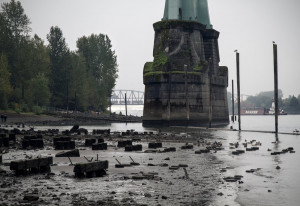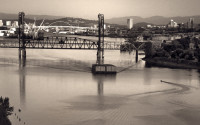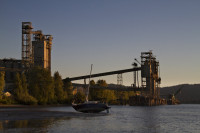



On Tuesday Dec. 17, 2019 at 11:30 a.m. Joseph Gallivan interviews Photographer Jon Gottshall [ponounced GOTCH-ALL] about his show 16 Cranes, which is on now at Gallery 114 through December 27. School teacher Gottshall made a dozen trips to the Willamette River superfund site between Kelly Pointe Park and Swan Island, photographing the busy industrial waterway and the wildlife it supports. He talks about the tension between those two states, teaching students how to make a photo, and dodging and burning in digital.
FROM THE PRESS RELEASE:
Gallery 114 December Exhibit
Jon Gottshall
“16 Cranes”
Opens: Thursday, December 5th, 3 pm to 9pm
Closes: Saturday, December 28th, 6 pm
The title of John Gottshall’s photographic essay is based on the number of industrial cranes set along the river from the Fremont Bridge to the mouth of the Willamette—the Portland Harbor. The exhibit consists of landscape photographs of Portland's most industrialized and polluted corridor, the last 10 miles of the Willamette River before it merges with the Mighty Columbia. Portland depends on this stretch of the river to stay connected to the global economy. 65,000 jobs are either directly or indirectly supported by businesses along the harbor. For example, a total of $413 million in state and local taxes was generated by activity in the Portland Harbor in 2015.
The Willamette River is served by boat, train, truck and pipeline. It is also the home of Portland Harbor's Superfund site, where toxic chemicals from Petroleum Distillates, Creosote and PCB's reside in the sediments along and under the riverbank. The river is also the home to fish, birds and mammals.
The exhibit explores existential questions, relevant in this age of environmental crisis:
1. How will all of these issues, the man-made and the ecological, coexist in the future?
2. Can we remedy what the past has done while toxin-heavy industries continue to use the river today and for the foreseeable future.
Gallery 114
1100 NW Glisan Ave
Portland
Gallery hours- 12-6 Th- Sun
To hear previous episodes of this show or any of our KBOO public affairs programming, just go to KBOO dot F-M or listen on iTunes, Google Play, or wherever you get your podcasts.
Joseph Gallivan has been a reporter since 1990. He has covered music for the London Independent, Technology for the New York Post, and arts and culture for the Portland Tribune, where he is currently the Business Reporter. He is the author of two novels, "Oi, Ref!" and "England All Over" which are available on Amazon.com
This show was recorded at KBOO on Dec 14, 2019 in Production 2.
- KBOO


